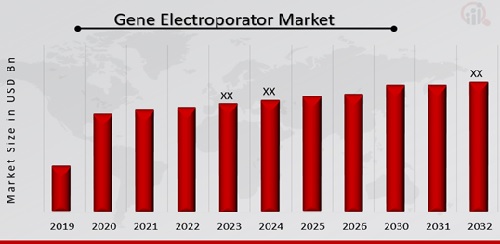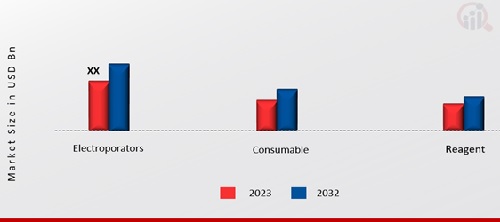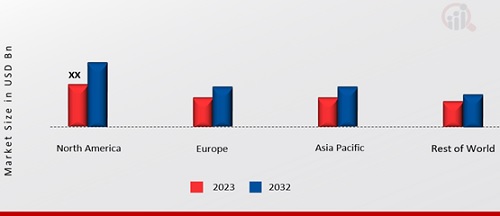Global Gene Electroporator Market Overview
The industry is projected to grow from Significant Value in 2024 to Significant Value by 2032, exhibiting a compound annual growth rate (CAGR) of 6.00% during the forecast period (2024 - 2032). Increasing advancements in genetic engineering and growing biotechnology and pharmaceutical industries are the primary drivers propelling the market's expansion.

Source: Secondary Research, Primary Research, MRFR Database and Analyst Review
Gene Electroporator Market Trends
- Increasing miniaturization and portability are driving the market growth
Gene electroporators that are portable and small allow researchers more freedom while performing studies. They make it possible to conduct research in isolated or resource-constrained environments because they are portable and may even be utilized outdoors. When compared to bigger, more complicated systems, portable gene electroporators frequently provide more affordable options. Because of this, a larger group of researchers—including those with tight financial or spatial constraints can utilize them. Portable gene electroporators are intended to be simple to use and typically require little training to operate. For researchers who might not have a great deal of experience with electroporation methods, this reduces the entrance hurdle.
Additionally, Gene electroporators may now achieve better transfection efficiencies and improved accuracy in delivering genetic material into target cells because of advanced technologies, including automation, nanotechnology, and microfluidics. As a result, experimental results become more consistent and dependable. The incorporation of cutting-edge technology enables accurate regulation and enhancement of electroporation parameters, including pulse frequency, duration, and amplitude. This adjustment raises transfection efficiency, lowers cytotoxicity, and increases cell survival. Researchers may analyze cellular function at a higher precision by using microscale electroporation technology to transfect tiny populations of cells or even individual cells. Applications for this exist in stem cell research, cancer biology, and single-cell genomics.
Moreover, rapid on-site diagnostics are made possible by gene electroporators incorporated into point-of-care devices, which transfer genetic material for instantaneous examination. This makes it easier to quickly discover and identify genetic abnormalities, infectious infections, and biomarkers, which helps doctors make early decisions about treatment and management. Point-of-care gene electroporators are ideal for usage in isolated or resource-constrained environments with restricted access to centralized labs or specialist equipment. By enabling medical professionals to do genetic testing, screening, and treatment at the patient's request, they enhance healthcare results and accessibility for marginalized communities. Point-of-care gene electroporation devices enable quick triage, diagnosis, and treatment of afflicted persons in emergency medical and disaster response settings. In order to provide prompt treatments and containment measures, they allow healthcare professionals to swiftly analyze genetic predispositions, infectious disease epidemics, or biological threats. Thus, driving the Gene Electroporator market revenue.
Gene Electroporator Market Segment Insights
-
Gene Electroporator Type Insights
The Gene Electroporator Market segmentation based on type, includes electroporators, consumables, and reagents. In 2023, the electroporators segment dominated the market. Electroporators are tools used in molecular biology to introduce materials such as DNA or RNA into cells, using high-voltage electric pulses to break cell membranes momentarily. They make the effective transfection of foreign genetic material into a variety of cell types possible, making them indispensable instruments in genetic engineering, gene therapy, and cell biology research.
The consumable category is anticipated to be the fastest growing. Consumables are disposable tools or supplies used in lab investigations, such as pipette tips, culture plates, filters, and tubes. These materials are replenished frequently after being depleted during experiments because they are critical for carrying out investigations and analysis in a variety of scientific fields, such as biology, chemistry, and physics.
Latest Industry Developments in Gene Electroporator Type Segment
July 2024: Thermo Fisher Scientific has introduced an upgraded version of the Invitrogen™ Neon™ Transfection System, improving electroporation efficiency, pulse control, and throughput capabilities, reducing cell damage and increasing transfection success rates.
April 2024: Lonza has introduced the 4D-Nucleofector™ X Unit, a high-performance pulse generator and user-friendly interface for efficient electroporation processes in cell engineering applications, including gene editing and therapeutic development.
Figure 1: Gene Electroporator Market by Type, 2023 & 2032 (USD Billion)

Source: Secondary Research, Primary Research, MRFR Database and Analyst Review
Gene Electroporator Application Insights
Based on Application, the Gene Electroporator Market segmentation includes academic and research institutes, pharmaceutical and biotechnology companies, and others. In 2023, the academic and research institutes category generated the most income. Centers of higher learning and research are scientific and educational establishments whose goals are to carry out research, increase understanding, and prepare the next generation of experts and scientists. They frequently work with other organizations and sectors to promote innovation and solve societal issues. Their areas of concentration are broad, encompassing the natural sciences, social sciences, engineering, and humanities.
The Gene Electroporator pharmaceutical and biotechnology companies segment market is anticipated to grow fastest during the forecast period. This is due to the research, creation, production, and marketing of drugs, biologics, and medical devices, which are the activities of pharmaceutical and biotechnology corporations. Assuring the safety and efficacy of their goods via rigorous research and clinical studies, they play a critical role in bringing innovative medications and therapies to the market. These firms greatly aid the progress in healthcare and illness treatment.
Gene Electroporator Regional Insights
The study provides market insights into North America, Europe, Asia-Pacific, and the Rest of the World by region. The North American Gene Electroporator market will dominate this market. Large academic and research institutions, top biotechnology and pharmaceutical businesses, and substantial government financing for science are the causes of this. Specializing in biotechnology and life sciences equipment, the area is also home to several established manufacturers and creative startups. Novel gene therapy strategies are needed because hereditary abnormalities and chronic illnesses are becoming more common in North America, and there is also a rising desire for individualized medication. A flexible platform for delivering therapeutic genes and editing tools is provided by gene electroporation technology, which may be used to solve unmet medical requirements and spur commercial expansion in the area.
Further, the major countries studied in the market report are the US, Canada, Germany, France, the UK, Italy, Spain, China, Japan, India, Australia, and South Korea.
Figure 2: Gene Electroporator Market Share By Region 2023 (USD Billion)

Source: Secondary Research, Primary Research, MRFR Database and Analyst Review
Europe's Gene Electroporator market accounts for the second-largest market share. Europe makes large investments in R&D, especially in genetics, biotechnology, and customized medicine. The expansion and acceptance of the gene electroporation industry is fueled by government funding, commercial investment, and cooperative research programs that foster technological innovation and advancement. Further, the German Gene Electroporator market held the largest market share, and the UK Gene Electroporator market was the fastest-growing market in the European region.
The Asia-Pacific Gene Electroporator Market is expected to grow at the fastest CAGR from 2024 to 2032. The increased burden of infectious diseases, chronic illnesses, and genetic disorders across Asia Pacific countries is driving the need for cutting-edge genetic technology and therapeutics. A flexible platform for administering gene-based treatments, vaccinations, and diagnostics is provided by gene electroporation technology, which helps to fill gaps in the medical community and propels regional market expansion. Moreover, China’s Gene Electroporator market held the largest market share, and the Indian Gene Electroporator market was the fastest-growing market in the Asia-Pacific region.
Gene Electroporator Key Market Players & Competitive Insights
The industry's leading players will keep spending a lot of money on research and development to increase their product lines, which will propel the Gene Electroporator market's growth. Contractual agreements, mergers and acquisitions, increased investments, collaboration with other companies, and the production of new products are examples of significant market developments. To increase their worldwide reach, market players also take part in a variety of strategic initiatives. In order to survive and expand in a more competitive and dynamic market, the Gene Electroporator industry must offer reasonably priced products and services.
One of the main strategies manufacturers use in the worldwide Gene Electroporator market is local manufacturing, which expands the market sector and helps customers by lowering operating costs. The Gene Electroporator industry has recently provided some of the largest medical advantages. Major players in the Gene Electroporator market, including Thermo Fisher Scientific, Lonza, Bio-Rad, Eppendorf, AngioDynamics, MaxCyte, Harvard Bioscience, Inc, Nepa Gene Co., Ltd, BEX CO.LTD, Merck, and others, are making investments in R&D activities in an effort to boost market demand.
Thermo Fisher Scientific Inc., a producer of analytical instruments and life sciences solutions, offers lab, drugs, biotechnology, and specialized diagnostics services. The company's product line includes molecular biology and nucleic acid analysis products, chemicals, cell culture materials, instruments for protein and cell analysis, laboratory supplies, equipment, and instruments for clinical and diagnostic purposes. Many industries, including biotechnology, pharmaceutical, food and beverage, forensics, industrial and applied sciences, and healthcare sectors, use Thermo Fisher's equipment and services. Industry-specific catalogs, e-commerce capabilities, supply-chain management services, and direct sales representatives are how the business runs its distribution.
One provider of contract manufacturing and research solutions is Lonza Group Ltd. It provides services in clinical development, production, and commercial mammalian and microbial manufacture. In addition, it provides high-potential active pharmaceutical components, sophisticated intermediates, cell and gene therapy capabilities, cell-culture models, genome editing, endotoxin products, research media, and testing goods. Lonza offers solutions for material protection, composites, and microbiological and hygienic management. Lonza provides services to consumers and health goods manufacturers, formulators, government agencies, and the biotechnology, pharmaceutical, academic, and research sectors.
Key Companies in the Gene Electroporator market include
- Thermo Fisher Scientific
- Lonza
- Bio-Rad
- Eppendorf
- AngioDynamics
- MaxCyte
- Harvard Bioscience, Inc
- Nepa Gene Co., Ltd
- BEX CO.LTD
- Merck
Gene Electroporator Industry Developments
April 2022: Bio-Rad made notable advancements in the electroporator industry. Recently, the Gene Pulser XcellTM Electroporation System was created. Bio-Rad manufactures the Gene Pulser XcellTM Electroporation System, a flexible tool for transfecting nucleic acids into a variety of cell types. It provides accurate control over electrical factors such as pulse length and voltage, resulting in effective and consistent transfection outcomes. Applications like gene therapy, drug discovery, and molecular biology research frequently employ this technology.
April 2022: Thermo Fisher Scientific Inc., an American provider of scientific apparatus, reagents, consumables, and software services, announced the launch of the Gibco CTS Xenon Electroporation System. The product aims to make cell treatments more feasible.
Gene Electroporator Market Segmentation
Gene Electroporator Type Outlook
- Electroporators
- Consumable
- Reagent
Gene Electroporator Application Outlook
- Academic and Research Institutes
- Pharmaceutical and Biotechnology Companies
- Others
Gene Electroporator Regional Outlook
- North America
- Europe
- Germany
- France
- UK
- Italy
- Spain
- Rest of Europe
- Asia-Pacific
- China
- Japan
- India
- South Korea
- Australia
- Rest of Asia-Pacific
- Rest of the World
- Middle East
- Africa
- Latin America
| Report Attribute/Metric |
Details |
|
Market Size 2023
|
NA (USD Billion)
|
|
Market Size 2024
|
NA (USD Billion)
|
|
Market Size 2032
|
NA (USD Billion)
|
|
Compound Annual Growth Rate (CAGR)
|
33.3 % (2024 - 2032)
|
|
Report Coverage
|
Revenue Forecast, Competitive Landscape, Growth Factors, and Trends
|
|
Base Year
|
2023
|
|
Market Forecast Period
|
2024 - 2032
|
|
Historical Data
|
2019 - 2023
|
| Report Coverage |
Revenue Forecast, Market Competitive Landscape, Growth Factors, and Trends |
| Segments Covered |
Type, Application, and Region |
| Geographies Covered |
North America, Europe, Asia Pacific, and the Rest of the World |
| Countries Covered |
The US, Canada, Germany, France, UK, Italy, Spain, China, Japan, India, Australia, South Korea |
| Key Companies Profiled |
Thermo Fisher Scientific, Lonza, Bio-Rad, Eppendorf, AngioDynamics, MaxCyte, Harvard Bioscience, Inc, Nepa Gene Co., Ltd, BEX CO.LTD, and Merck |
| Key Market Opportunities |
Expanding applications in gene therapy and advancements in CRISPR-based technologies |
| Key Market Dynamics |
Increasing advancements in genetic engineering and growing biotechnology and pharmaceutical industries |
Frequently Asked Questions (FAQ) :
The Gene Electroporator Market size was valued at Significant Value in 2023.
The global market is projected to grow at a CAGR of 6.00% during the forecast period, 2024-2032.
North America had the largest share of the global market.
The key players in the market are Thermo Fisher Scientific, Lonza, Bio-Rad, Eppendorf, AngioDynamics, MaxCyte, Harvard Bioscience, Inc., Nepa Gene Co., Ltd, BEX CO.LTD, and Merck, among others.
Electroporators category dominated the market in 2023.
Academic and Research Institutes had the largest share of the global market.

















